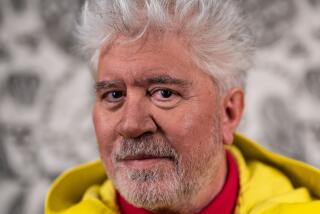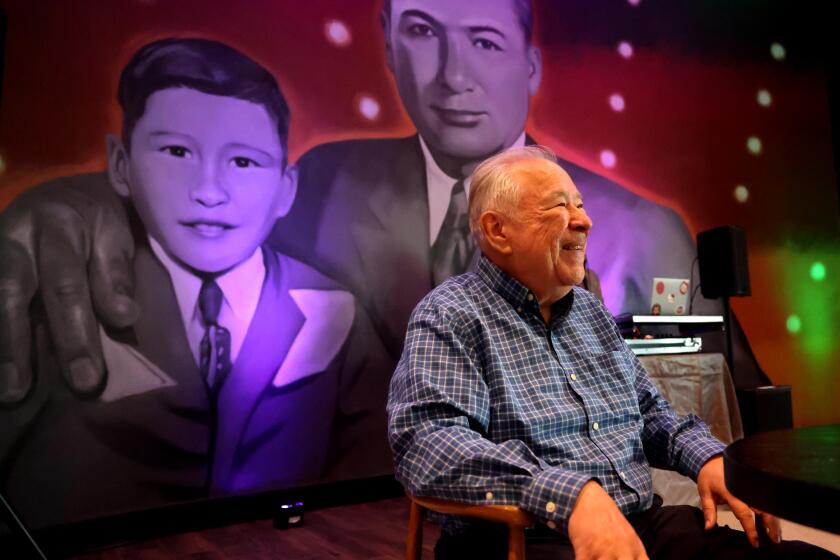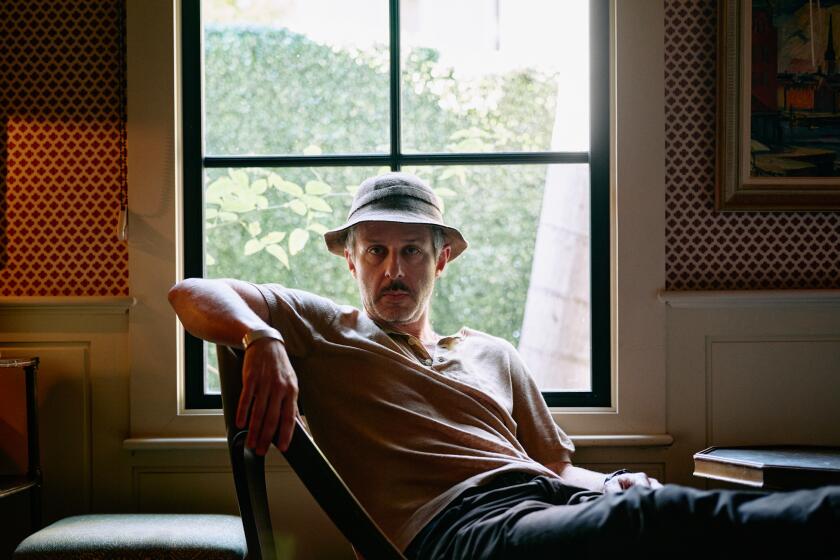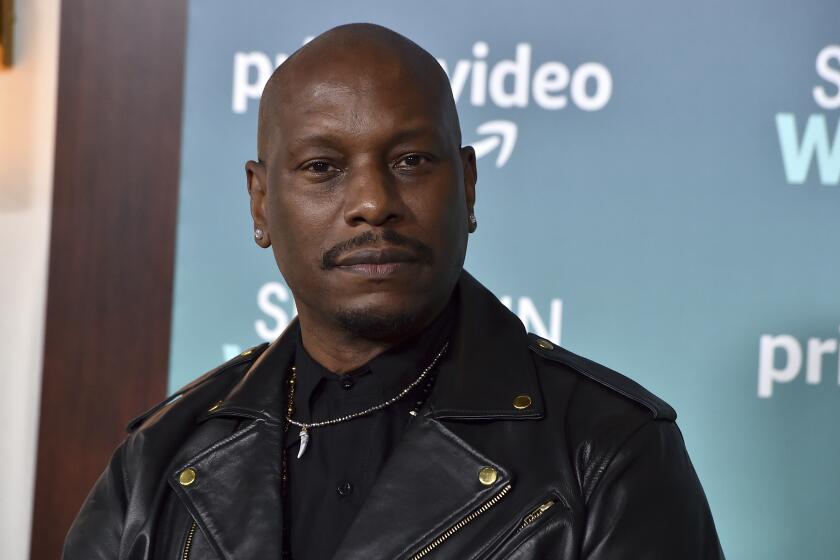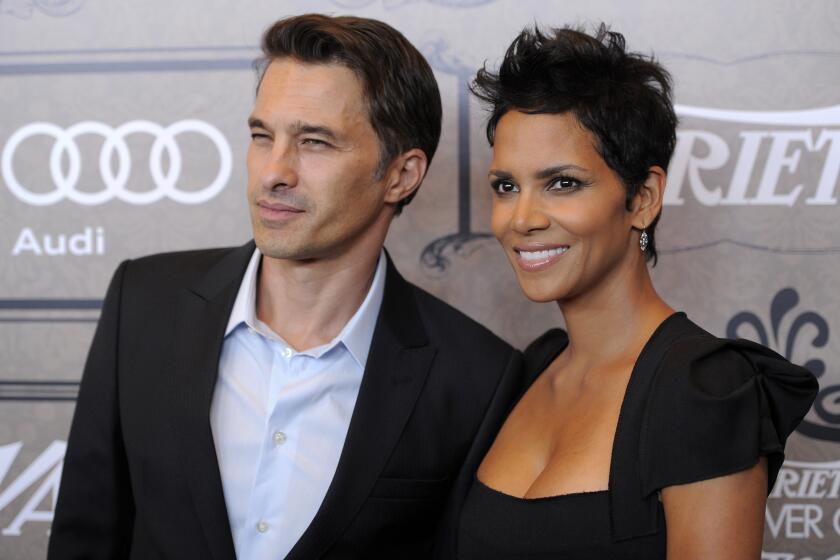The Big Picture
You’re in the audience as Greg MacGillivray’s film classic “To Fly” begins:
An 18th century balloonist, in top hat and tails, is regaling a crowd of farmers about the wonders of flight. A brass band plays as he drops the sandbag ballast. And, as he ascends, the excited balloonist yells down to the awe-struck crowd, “It’s magical! I wish you could all see it from here.”
Suddenly, you can.
In an instant, the 15-foot-high and 20-foot-wide projected image expands to the screen’s full dimensions: a staggering six stories high and 110 feet wide, a peripheral-vision-encompassing screen that makes viewers feel as if they are in the balloon as it glides high above the countryside.
It’s a pure IMAX moment, the kind MacGillivray does best.
“We’re one minute and 20 seconds into the movie before we show the audience how big the screen is actually going to be,” the filmmaker says. “Without exception, there’s a noticeable ‘ooh’ from the crowd when that happens. It’s one of the most memorable IMAX kind of experiential moments from all of our films.”
It’s those experiential moments--from nature, science, exploration--that distinguish MacGillivray’s medium from other types of filmmaking. Thinking big, delivering big.
As one of the premier producers and directors of IMAX films--the frame is 10 times larger than standard 35-millimeter--he has made more of the large-format movies than any independent filmmaker: 18 over the past 20 years, with four more in various stages of production.
MacGillivray, 50, began shooting 8-millimeter films for fun as a Corona del Mar teenager in the late 1950s. Today, Laguna Beach-based MacGillivray Freeman Films works with $5-million budgets to create films shown in science centers, museums and an increasing number of commercial venues.
When MacGillivray began making IMAX films two decades ago, there were only four IMAX theaters; today there are more than 130 worldwide, including the newest, built by Edwards Theaters, which opened Friday in Irvine.
MacGillivray’s films--such as “To Fly,” which has run continuously at the Smithsonian Institution’s National Air and Space Museum since 1976 and is currently shown in 10 other theaters worldwide--have a theatrical shelf life unheard of in Hollywood.
“To Fly,” a visually stunning history of manned flight, was MacGillivray’s first IMAX film. One of his latest, “The Living Sea,” has been nominated for an Academy Award in the documentary short-subject category.
“The Living Sea,” a 37-minute film that celebrates the world’s oceans, opened to sold-out crowds at the Reuben H. Fleet Space Theater in San Diego last month.
It’s only the second IMAX film nominated for an Oscar--and MacGillivray’s first.
He was skiing in Mammoth with his family when the nominations were announced. His wife, Barbara, tracked him down on the slopes to tell him the news.
“He got very teary,” she recalls. “He was just completely shocked. He never even thought it would be possible.”
MacGillivray’s Oscar nomination comes on the heels of the Library of Congress selecting “To Fly” as one of 25 films for inclusion this year in the National Film Registry.
“From my vantage point, I think Greg understands the medium as a communication technology perhaps better than anybody else,” says Jeff Kirsch, executive director of the space theater in San Diego and executive producer for the Museum Film Network, a worldwide group of 14 museums that finances large-format films.
The network has funded two MacGillivray Freeman productions. “To the Limit,” a 1989 film, follows three athletes--a prima ballerina, a mountain climber and a downhill ski racer--and explores, via endoscopic photography, what the body goes through under certain physical conditions. “Storm Chasers,” a 1995 film, takes the audience around the globe to experience extreme storms, monsoons, hurricanes and tornadoes.
Walter J. Boyne, former director of the National Air and Space Museum, ranks MacGillivray “at the very top” of IMAX filmmakers.
“He is perhaps the most versatile and most imaginative of those I’m familiar with and I know quite a few of them,” says Boyne, adding that “To Fly” was “really the benchmark for the [IMAX] industry. Its success at the National Air and Space Museum and subsequent success [in other theaters] made it possible for the IMAX theater explosion that followed.”
Reflecting on MacGillivray’s success, Bill Bennett, president of MacGillivray Freeman Films Distribution Co., says his boss’ goal “is to always go one step further with each film that he makes.”
“If you went through the library of films, you’d be able to see the evolution of always doing something different that advances the format,” Bennett says. “It’s evident in each and every film that he’s made.”
*
MacGillivray never went to film school--he was too busy making films.
He received his first movie camera for Christmas when he was 13--an 8-millimeter Kodak his parents purchased with trading stamps. The budding Cecil B. DeMille shot footage of his buddies surfing and made short comedy films using his friends as actors.
MacGillivray set up patio chairs and screened his films in the garage. “He was never a discipline problem as a boy because he always had so many projects,” recalls his mother, Betty Gaye MacGillivray. “He was just busy all the time.”
By his sophomore year at Newport Harbor High School, MacGillivray had progressed to a 16-millimeter camera and began his first commercial film: a surf movie he shot along the coast between San Diego and Santa Cruz.
It took four years and cost $2,500. “I’d had a bunch of paper routes and gardening jobs, so I saved money and invested it in rolls of film,” he says.
“A Cool Wave of Color” premiered during MacGillivray’s freshman year as a physics major at UC Santa Barbara. With friends from his dorm to help with advertising and screenings, MacGillivray booked high school auditoriums up and down the coast.
It was a family affair, with his parents often helping sell tickets at the door and running the projector while MacGillivray narrated onstage. Even his grandmother occasionally got into the act, watching the exits for gate-crashers.
The film, which reviewers praised for its innovative use of color, editing and style, put him on the map as a surf filmmaker.
But even more surprising to MacGillivray than the critical success was when the film began showing a modest profit. Before the film’s release, it had never occurred to MacGillivray that he might be able to make a living with his movie camera. He had thought he’d wind up a high school math or physics teacher.
But after a year and a half, MacGillivray dropped out of UCSB.
By then, he had met Jim Freeman.
*
A kindred spirit a year older than MacGillivray, Freeman had grown up in Santa Ana and was a student at Loma Linda University in Riverside. They met at a showing of Freeman’s “Outside the Third Dimension,” which MacGillivray describes as “the only 3-D surf film ever attempted.”
The two young filmmakers hit it off immediately. “We had the same love of filmmaking, the technical side as well as the artistic side,” MacGillivray says.
Teaming up, they made “Free and Easy,” a 1967 surf-travel film they shot in South America and Hawaii.
As with their solo surf films, they shot without sound. They’d “borrow” music from record albums to accompany their live narration. Standing onstage together, they even supplied their own sound effects.
“We used to call it the Huntley-Brinkley technique, and we could do little routines where we played off one another,” MacGillivray says. “The narrations always had to be comical. You were basically up there as an entertainer, and you weren’t trying to create any important moment or social change or whatever, so you tried to be funny.”
MacGillivray and Freeman went on to make five surf films together, including their last and best-known, “Five Summer Stories,” released in 1972. The film was recently released on video with profits going to the Surfrider Foundation and other environmental causes, a longtime concern of MacGillivray’s.
By the early ‘70s, MacGillivray and Freeman began branching out. They filmed the flight scenes for “Jonathan Livingston Seagull,” the opening helicopter shots for “The Towering Inferno” and a surfing sequence in “The Sweet Ride,” a forgettable feature film starring Jacqueline Bisset.
They also did a series of four educationally based, nonverbal short films used by teachers to inspire students to write, such as “The Perfect Moment,” about the external and mental conditions that must come together for athletes to excel. The films are still shown in classrooms around the country.
And they made more than three dozen television commercials for clients ranging from Del Monte to the Ford Motor Co.
While scouting locations for a Kodak commercial in 1976, Freeman, 32, was killed in a helicopter crash.
When they got the news, MacGillivray and his wife were in Washington, D.C., preparing for the premiere of “To Fly.”
“I can remember the moment,” he says. “It was just earth shattering.”
The reverberations from the crash in the mountains near Bishop, Calif., continued for years.
“[Greg] didn’t know if he could carry on with filmmaking,” Barbara says. “For a while, he really questioned that. They were real close friends; they were kind of soul mates in cinema.”
But MacGillivray learned to cope.
“We relied on each other for feedback, and we trusted each other’s advice,” he says. “Jim was so good at talking to people too. He used to do all of our interviewing and promotion and publicity-seeking and all that stuff, and I could just sit back and make films, so I had to learn how to do all that and”--he laughs--”become a little more personable.”
As a tribute to his partner and their films, MacGillivray kept Freeman in the company name.
*
MacGillivray’s job frequently takes him far from home, which is the bottom two floors of a three-story former apartment building in Laguna that he bought in the early ‘70s. It’s right on the beach, facing a prime surfing spot.
He and Barbara met in a high school chemistry class, where they were lab partners. “We just sat there and laughed and made jokes all the time,” she recalls.
Barbara MacGillivray, a clinical psychologist in Orange County’s Children Youth Services, has a continuing, active interest in her husband’s work. It began with his first film, “A Cool Wave of Color,” when she accompanied him on shoots.
“That’s what our dates were,” she says. “We’d go out and shoot surf. It’s just been part of our relationship. I’ve been on many, many film expeditions, doing all kinds of things.”
The couple and their two children, Shaun, 16, and Meghan, 13, are all avid surfers or Boogie-boarders and snorkelers.
Those who know MacGillivray describe him as low-key, easygoing and self-effacing. But he’s not laid-back, Barbara says: “He’s extremely intense, extremely organized, efficient and focused in using his time.”
Still, he’s no workaholic.
“He can just cut if off and play as hard as he works,” Barbara says. “He really puts a priority on family time. We’ve tried to have the kids go with us on as many [location] shoots as possible. They’ve been all over the world with us.”
*
MacGillivray logs about 100,000 miles a year. His 1995 calendar was studded with filmmaking trips to Arkansas, New Mexico, Louisiana, Texas, Florida, New England, Costa Rica and France.
In January, MacGillivray was off to Singapore, where he joined his crew for three weeks of shooting “One Fine Day,” a day in the life of 10 Singaporeans. It will be shown at a theater being built in Singapore specifically for the film.
Recently, he and his crew have been in El Centro, Calif., shooting the Blue Angels for a new IMAX film, “The Magic of Flight.”
Despite more than 20 years making such films, MacGillivray says each one is a challenge because the subjects are different.
Among current projects is a film about an international team of climbers attempting to reach the summit of Mt. Everest. It will be the first Everest ascent filmed in the IMAX format.
Unlike filmmakers he knows who went the Hollywood route and spend much of their time waiting months or years for studio approval of projects, MacGillivray has had no such career lulls.
“I’m happy I’ve been able to continue to be busy and make films that, for me, are more rewarding in terms of inventiveness and creating a new genre,” he says.
Retirement has crossed his mind, but MacGillivray says such thoughts quickly pass: “The thing I really love about what I do is the variety. Just the study of different subjects and the whole act of filmmaking.
“I’m making these films because they’re enriching for the audience, and they last. They don’t just go out like a TV show and get shown once and you don’t ever get any further enjoyment out of it.”
And then, he says, there is that rush: “The thrill comes when you see the image on the big screen and it’s just like you saw it when you were out there filming. That’s what’s really exciting.”
(BEGIN TEXT OF INFOBOX / INFOGRAPHIC)
Greg MacGillivray
Age: 50.
Background: Born in San Diego, grew up in Corona del Mar. Lives in Laguna Beach with Barbara, his wife of 16 years, and their two children--Shaun, 16, and Meghan, 13.
Passions: Surfing, volleyball, skiing, reading and movies. “I spend a lot of time looking at and studying films. I try to keep abreast of what’s going on with special effects and new creative ways to make movies.”
On what makes a good IMAX film: “With IMAX, story is important, but your key visual moments--the moments that are experiential--are probably more important than story. When you’re thinking about an IMAX film, you’re thinking about having two, three or four key experiential moments that the audience can remember and truly feel are extraordinary.”
On the appeal of making movies: “I always liked the magic that’s involved in making movies, where you’re basically the magician: You’re creating something out of nothing, and if it succeeds, it entertains in a unique way. The joy for me is always seeing the results of your work--and you need the joy because it’s such a hard thing to do and it’s certainly not profitable every time.”
More to Read
Only good movies
Get the Indie Focus newsletter, Mark Olsen's weekly guide to the world of cinema.
You may occasionally receive promotional content from the Los Angeles Times.
